Summary
• Latest scientific research was considered in revising amino acid recommendations for laying hens.
• Considering that methionine is the first limiting amino acid in laying hen diets, a meta-analysis revealed an optimal digestible methionine intake of 415 mg/hen/d.
• Literature suggested optimal digestible methionine, methionine+cysteine, threonine, tryptophan, arginine, isoleucine and valine to digestible lysine ratios of 50, 91, 70, 21, 104, 80 and 88 %, respectively.
• If dietary metabolisable energy needs to be reduced, then essential amino acids also should be reduced, but to a lesser extent.
• Optimising the dietary amino acid profile and feed cost reduction can only be achieved with the complete set of commercially available amino acids.
• Considering that methionine is the first limiting amino acid in laying hen diets, a meta-analysis revealed an optimal digestible methionine intake of 415 mg/hen/d.
• Literature suggested optimal digestible methionine, methionine+cysteine, threonine, tryptophan, arginine, isoleucine and valine to digestible lysine ratios of 50, 91, 70, 21, 104, 80 and 88 %, respectively.
• If dietary metabolisable energy needs to be reduced, then essential amino acids also should be reduced, but to a lesser extent.
• Optimising the dietary amino acid profile and feed cost reduction can only be achieved with the complete set of commercially available amino acids.
Introduction
During recent decades productivity of laying hens increased substantially (Elliot, 2008). Not only egg number, egg mass, and feed conversion has increased but also persistency of lay has improved. As such, this must have implications on the optimal amino acid nutrition of current laying hen strains. Simply stated, increasing egg mass output per hen means an increased amino acid output which has to be provided by the feed. Moreover, while performance criteria of laying hens have improved, body weight has decreased (Elliot, 2008). Consequently, the amino acid requirement for maintenance purposes is influenced. In addition to the quantitative demands for amino acids by the modern laying hen changing, there also is the potential that the qualitative demands for dietary protein might have changed as optimum amino acid composition for egg production differs from that for maintenance.Therefore, the current amino acid recommendations for layers provided by Evonik Degussa Feed Additives have been revised. Since methionine is considered the first limiting amino acid in most common diet compositions, literature was screened for methionine response studies in order to derive a value for optimum dietary methionine level. Subsequently, the optimum amino acid profile was defined by means of recent ideal protein research which ultimately allowed for calculating optimal dietary amino acid levels for modern laying hen strains.
Several methionine dose response studies with laying hens are available
International literature was searched for methionine dose-response studies with laying hens in order to perform a meta-analysis. Thirteen papers were published since 1990 reporting 19 experiments which were suitable for this survey (Table 1). Age of laying hens ranged between 18 and 64 weeks but on average trials were performed from 24 to 39 weeks of age. Moreover, various genetics were used in these trials including Hy-Line W-36, Lohmann LSL, Lohmann brown, Single Comb White Leghorn, Hisex brown, Dekalb delta, and ISA Babcock hens. However, because of the limited number of trials, it was not possible to derive specific amino acid recommendations for individual strains.There were considerable differences in diet compositions between these trials as the ingredients used, protein and amino acid levels, and metabolisable energy contents varied. At least it can be stated that all basal diets were deficient in methionine (Met) and methionine+cysteine (Met+Cys), otherwise the hens would not have responded to increasing levels of supplemental DL-Met. In order to avoid or at least to reduce interactions between performance data and digestibility of the dietary Met, all performance data were regressed against digestible Met or Met+Cys. However, some publications only reported total amino acid contents of the diets, and in those cases, the digestible amino acid levels of the diets were recalculated using AminoDat 3.0® software (Degussa 2006). Digestibility figures origin from broiler research as digestibility research on laying hens is scarce.
The basic idea of meta-analyses is to put data of many experiments together in order to analyse them in one process. In this context the challenge of the present survey was dealing with high variation of response data within a trial but particularly between trials. In order to reduce this variability, egg mass per hen per day was considered as key performance parameter. However, when egg mass/hen/day was plotted against dietary digestible Met content, data were still relatively variable and regression analysis revealed a relative poor fit (r2 = 0.24, Figure 1). One goal of the nutritionist is to ensure a least intake of nutrients which is the result of dietary concentration and feed intake. As feed intake is influenced by a number of factors such as body weight (an effect of strain) nutrient intake is considered to be a better basis for standardisation. Therefore, the data were standardised to digestible methionine intake.
Physiological feed back mechanisms allow laying hens to eat according to the first limiting nutritional factor, which is usually dietary energy. So, differences in dietary energy levels must have implications
Table 1: Methionine and Methionine+Cysteine dose response studies which were considered
in the meta-analysis
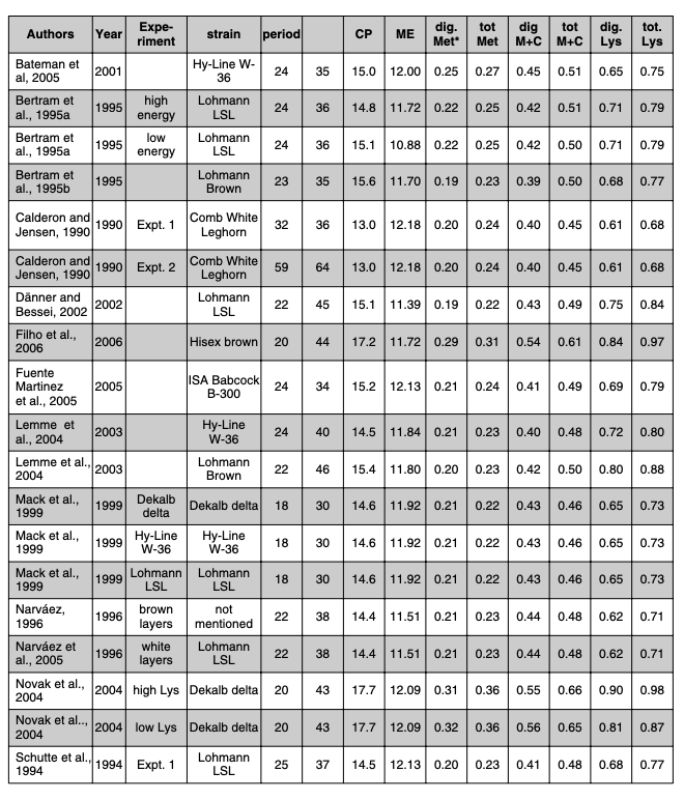
on feed intake and consequently on Met intake. Regressing daily egg mass data against daily digestible Met intake per MJ ME improved the fit of the regression curve to a reasonable r-square of 0.78 (Figure 2).
Finally, data were analysed by exponential regression as suggested by Morris (2004), who demonstrated that performance response curves to amino acid levels of a population of animals are of non-linear nature. The 19 experiments delivered 97 data points, and the resulting regression equation suggested that 35.15 mg Met intake/MJ ME/hen/d is optimal (95 % of asymptotic response). This number cor
Figure 1: Daily egg mass data out of 19 experiments plotted against the digestible methionine
content of the diet
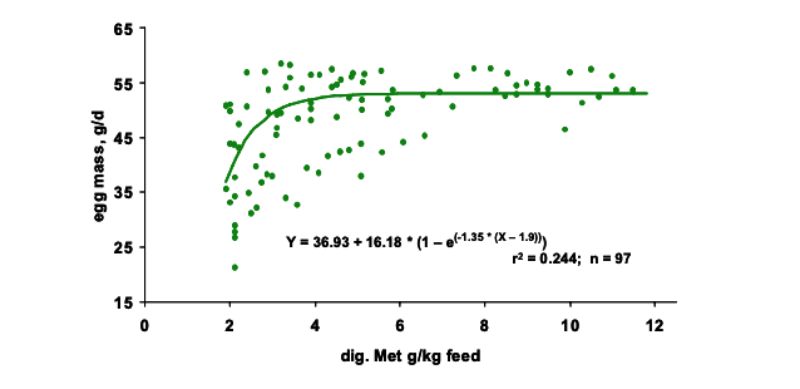
Figure 2: Daily egg mass data out of 19 experiments plotted against the daily digestible
methionine intake which was standardised to the dietary energy content
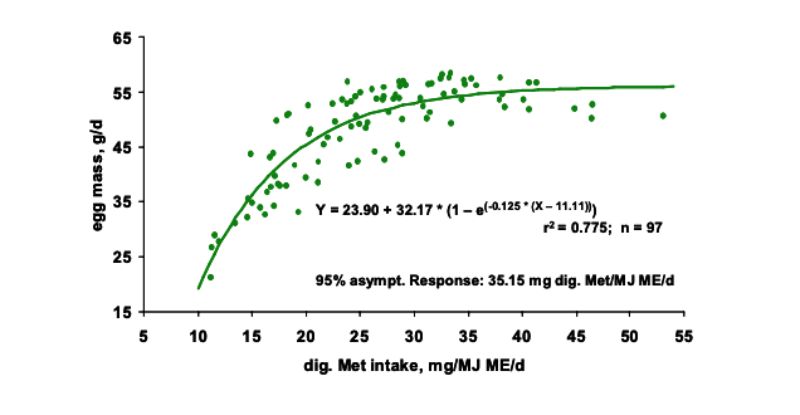
responds to a daily intake of 415 mg of Met using a dietary energy level of 11.82 MJ ME, which was the average across all considered studies. This number of 415 mg dig. Met/hen/d is about 6 % higher than our current recommendation (390 mg/hen/d) but in line with that suggested by Joly (2007), who estimated 420 mg dig. Met/hen/d.
The procedure applied for digestible methionine was also applied for digestible methionine + cysteine levels (Figure 3). Accordingly, the resulting optimum is 65.76 mg digestible Met+Cys intake/MJ ME/hen/d corresponding to 777 mg dig. Met+Cys/hen/d. This value is about 13 % higher than the current Evonik recommendation of 690 mg/hen/d.
While the determined optimum supply of 415 mg dig. Met/hen/d and 777 mg dig. Met+Cys/hen/d may initially seem high, these levels suggest an optimum dig. Met to dig. Met+Cys ratio of 54 %. This ratio is similar to that suggested by Bregendahl et al. (2008), who determined an optimum dig. Met to
Figure 3: Daily egg mass data out of 19 experiments plotted against the daily digestible
methionine+cysteine intake which was standardised to the dietary energy content

Met+Cys ratio of 52 and 55 % based on daily egg mass and feed conversion ratio data out of two consecutive experiments, respectively. It also agrees with Rostagno (2005), who recommended a dig. Met to Met+Cys ratio of 55 %. However, this estimate is lower than Joly (2007), who suggested 650 mg dig. Met+Cys/hen/d to be optimal which would corresponds to a dig. Met to Met+Cys ratio of 65 %. The ratio of Joly (2007) suggests a considerably lower Cys requirement of the birds as the dig. Met level by Joly (2007) is quite in line with our findings. Finally, suggestions by Leeson and Summers (2005) and Coon and Zhang (1999) were 58 % and 60 %, which are slightly higher than our findings, but lower than those of Joly (2007).
Ideal Protein Profiles
Although Met and Met+Cys, respectively, play a key role in laying hen nutrition because they are first limiting in most common commercial diets, lysine is typically used as the reference amino acid in the Ideal Protein concept. The advantage of this concept is that all essential amino acids are considered because optimising performance requires that the whole range of essential amino acids are provided to the animal in adequate amounts. Recently, Bregendahl et al. (2008) published an extended study on the Ideal Protein profile of modern laying hens, but there are several other references for this topic including Jais et al.(1995), Coon and Zhang (1999), Rostagno (2005) and Leeson and Summers (2005). Respective ideal protein profiles are listed in Table 2.There is a good consistency between the suggested profiles although methodologies applied to derive the values differed with a couple of exceptions. For example, compared with all other studies indicating an average value of 50 % for the dig. Met to Lys ratio, Jais et al. (1995) reported 44 %, which seemed to be too low. Suggested Met+Cys to Lys ratios ranged from 81 % (Coon and Zhang, 1999) to 96 % (Bregendahl et al., 2008) and showed thus higher variability. With respect to Thr, Leeson and Summers (2005) suggested a relatively high ratio to Lys (80 %) whereas Rostagno (2005) recommends a rather low figure (66 %). Regarding Trp:Lys the ratio provided by Jais et al.(1995) was substantially lower compared to the other references. Likewise, the suggested Arg to Lys ratio of 130 % by Coon and Zhang (1999) is considerably higher than those by Rostagno (2005) and Leeson and Summers (2005) and especially by Jais et al. (1995). Similar findings apply for Val to Lys ratios. Ile to Lys ratios varied between 76 % and 86 %.
Table 2: Ideal amino acid profiles proposed by different authors
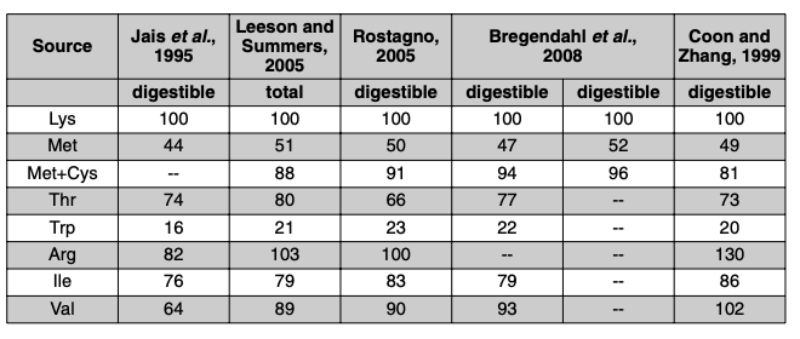
Recommended amino acid levels for layers have been increased
Based on our meta-analysis and the above mentioned ideal protein sources we revised our current amino acid recommendations for laying hens, which are reported in Table 3. The basis of our revised recommendations is the optimum daily intake of 415 mg dig. Met/hen which was the outcome of our meta-analysis. In a second step, optimal intake of the other amino acids was calculated by using the ideal ratios which are presented in Table 3. Those ratios were more or less the average of the numbers given in Table 2. The Met to Lys as well as the Trp to Lys ratio reported by Jais et al. (1995) were excluded. For the optimal Met+Cys to Lys ratio also the Met to Met+Cys ratio derived from our meta analysis was considered. Although numbers in Table 2 suggest a Thr to Lys ratio of 74 % we rather suggest to use a ratio of 70 %. Variation of literature data is large. Ratios referring to Bregendahl et al. (2008) refer to daily egg mass data. However, feed conversion responses suggested a ratio of 67 %. In addition, information from layer feed producers also suggests that optimal ratio might be lower than 74 %.An intake of 415 mg dig. Met/hen/d and an optimum dig. Met to Lys ratio of 50 % revealed a daily dig. Lys intake of 830 mg/hen/d (Table 3). Then, dietary levels were calculated using optimum daily intakes and assuming varying daily feed intakes from 80 to 120 g (Table 3). Accordingly, the concentration of amino acids (and ideally other nutrients and energy) increases with decreasing feed intake.
A recommended daily intake of 830 mg dig. Lys/hen might appear high, especially when compared with our previous recommendation of 770 mg/hen/d. However, in an experiment by Bonekamp et al. (2007), dig. Lys intake was increased from 550 to 800 mg/hen/d in two layer strains (Lohmann brown classic, Lohmann LSL classic). Note that in this trial, the whole amino acid profile was increased in conjunction with Lys, whereas energy and minerals were maintained. Responses on daily egg mass and feed conversion ratio were of non-linear nature (Figure 4). Exponential regression analysis indicated that the maximum daily egg mass and minimum feed conversion ratio were not achieved. Respective regression equations suggested that the optimal dig. Lys intakes were higher than the highest tested level but also clearly higher than 830 mg/hen/d, which imply that modern layers require high levels of dietary amino acids to realize their full genetic performance potential. Moreover, optimum amino acid levels for maximising performance seemed to be similar between strains.
Most of the studies used for the meta-analysis on sulphur amino acids and ideal protein were done with laying hens from start of lay to around peak production. Having typical egg production and egg weight curves in mind, it appears logic that optimum amino acid levels differ with age. Our recommendations as given in Table 3 are meant for layers up to peak production. In later phases when performance decreases, their amino acid requirements will also decrease, thus the dietary amino acid levels might be reduced.
Table 3: Recommendations for both digestible amino acid intake of laying hens and in %
of diet for laying hens with differing daily feed intake (Dietary energy: 11.82 MJ
ME/kg)
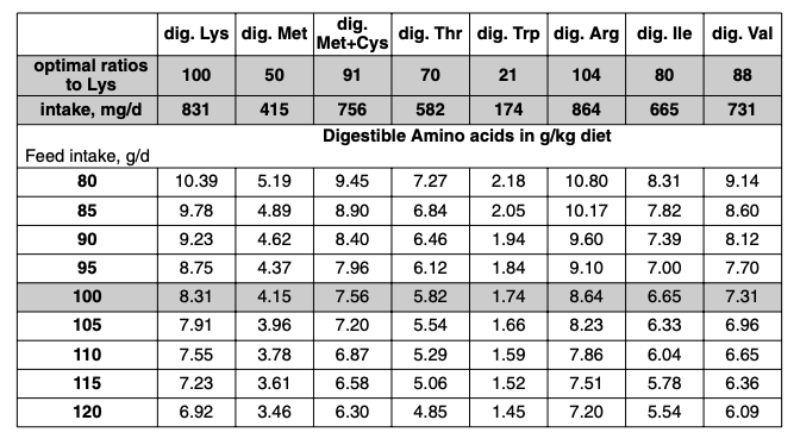
The potential for differences in the maintenance and production requirements and their subsequent differences in their ideal amino acid profiles also should be considered. The ratios suggested by Rostagno (2005) are applied for various body weights, weight gain, and daily egg mass of the hens but there is no consideration given to differences in maintenance and production resulting in changes of the ratios. However, the recommendations by GfE (1999) do consider those differences, but the recommended amino acid profile changes only marginally. Therefore, our recommended amino acid ratios (Lys=100) remain the same for all production phases for practical reasons.
Feed intake is influenced by dietary energy
Feed intake of laying hens is dependent on the dietary energy level. Morris (2004) referring to an earlier work of his lab from 1968 showed that laying hens reduce their feed intake as soon as dietary metabolisable energy (ME) content has been increased. However, Morris (2004) further reported that if dietary ME is increased and also the limiting amino acids are increased proportionally, hens gained fat. He concluded that a reduction in feed intake was not enough to maintain energy intake. As a solution, Morris (2004) suggested to use the effective energy concept which is more similar to net energy instead of metabolisable energy. The change in dietary metabolisable energy is often accompanied with a change in fibre and fat content, fractions which per definition have different energetic effectiveness. However, the effective energy concept has not been established in poultry nutrition.An experiment was conducted in which ISA brown layers were fed increasing levels of a well balanced protein at two metabolisable energy intakes (Wijtten et al., 2006). Energy intake of 294 kcal ME/hen/d and 314 kcal ME/hen/d were achieved by restricted feeding. Digestible Lys intake was increased from about 600 to 750 mg/hen/d at both energy intakes. At the same time the whole amino acid profile was raised maintaining ratios between the amino acids. Responses on daily egg mass are shown in Figure 5. Performance increased in a linear fashion with increasing levels of balanced protein at both energy intakes suggesting that higher levels would have been needed to achieve the asymptote. This effect again suggests that the optimal dietary dig. Lys level (and those of all other essential amino acids) is much higher than our former recommendation of 770 mg dig. Lys/hen/d.
Figure 4: Daily egg mass and feed conversion ratio of two layer strains fed graded levels of
balanced protein (Bonekamp et al., 2007)

Figure 5: Daily egg mass of ISA brown layers with graded levels of balanced protein intake
(True fecal digestible Lys given as reference) at two energy intakes (Wijtten et al.,
2006)
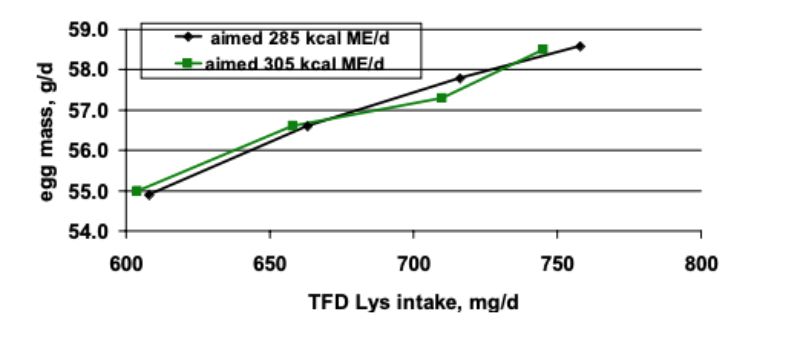
There was no difference between the two energy treatments indicating that if energy intake is reduced, amino acid intake should be maintained in order to keep performance at the same level (Figure 5). Differences in energy intake were achieved by controlling feed intake. Consequently feed conversion ratio was better at lower energy intake but the response to increasing dietary balanced protein (BP)
Figure 6: Body weight gains of ISA brown layers with graded levels of balanced protein intake
(True fecal digestible Lys given as reference) at two energy intakes (Wijtten et al.,
2006)
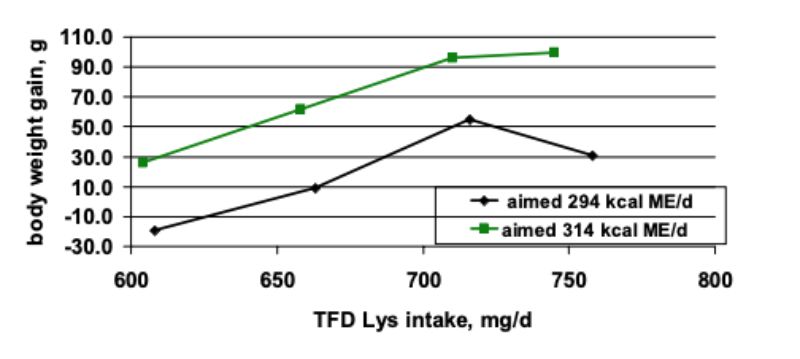
was again very similar at both energy intakes. Interestingly, both increasing dietary BP and energy intake levels affected body weight development of the hens over the 16-week experiment. Body weight increased with increasing BP (Figure 6). It is assumed that effects on body weight are mainly due to fat accretion, however, this has not been confirmed. Body weight gain was consistently higher at higher energy intake. Therefore, it was concluded that the higher energy intake could not be utilised for higher egg mass production, so the extra energy was stored as fat. These responses imply that an energy intake of 314 kcal ME/hen/d can be reduced as energy is partly used for weight gain which is not necessarily desired in layers.
Differences in energy intake can only be achieved by feed restriction. In case of changing ME levels in the diet, hens would respond with changes in feed intake in order to maintain energy intake. However, the current experiment suggests that controlling energy intake of hens might be a tool to control body weight (fat) gain of layers.
Raw material prices and availability force nutritionists to find alternative sources and concepts particularly when it comes to energy. In this context, the question arises how to adjust dietary amino acids if dietary energy is reduced. As mentioned above, Morris (2004) reported that proportional adjustment of amino acids with changes in dietary metabolisable energy is not satisfying. A recent literature survey suggests that amino acids levels in broiler diets should not be adjusted proportionally to changes in dietary energy in order to maintain performance and profitability (Lemme, 2007). Changes in dietary composition (fat, fibre, carbohydrates, protein) and their respective net energy or effective energy contents might partly explain this finding. This concept has been implemented in our QuickChick software, which gives amino acid recommendations for broilers. It suggests that relative changes in amino acid levels are only half of the dietary ME changes. When applying the same concept to layer amino acid recommendation, levels would change as presented in Table 4 where ME was reduced by 5 % to 11.23 MJ ME/kg.
Optimal dietary amino acid levels are influenced by economic conditions
Dietary amino acid specifications should allow for high performance. However, maximum performance does not necessarily mean maximum profitability. Therefore, nutrient specifications in general but amino acid specification in particular should be adjusted to the economic conditions including feed cost and egg price. In Figure 7, income over feed cost is used as a profitability indicator. The considerations for this calculation were: a general diet price of 180 EURO; a price increase of 1 EURO per 100 mg increase of daily dig. Lys intake (at 100g daily feed intake this corresponds to an increase of 0.1 % dig. Lys of the balanced protein); and 15 EURO per kg egg mass. These considerations were combined with predicted daily egg mass and feed conversion ratio using the respective exponential regression equations. Although the curve of Lohmann LSL hens was flatter than that of Lohmann brown hens, both curves did not achieve a maximum even at 830 mg dig. Lys intake/hen/d whichFigure 7: Income over feed cost calculations (IOFC) using experimental data (regression
equations) from Bonekamp et al. (2007) and assuming a basal feed price of 1.80
EURO/kg feed, 15.00 EURO/kg egg output, and a feed price increase of 1.00
EURO/100 mg higher dig. Lys (balanced protein) intake.
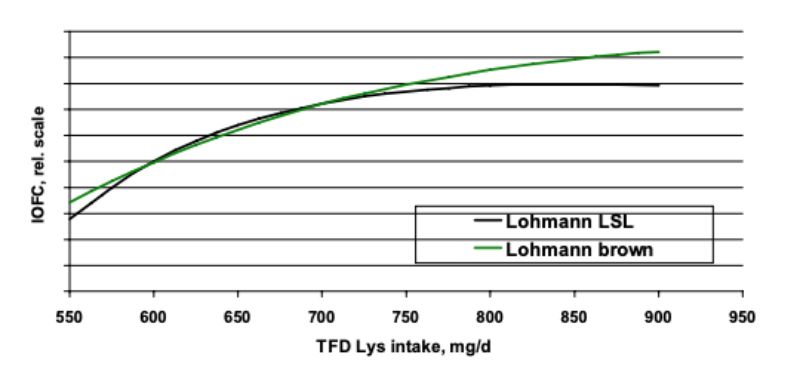
was outside the tested range in the experiment. Interestingly, general diet price did not impact optimal dietary amino acid levels. Stronger feed price changes per unit balanced dietary protein would reduce the economically optimal amino acid intake. Also price per kg egg mass influences optimal specifications.
Our revised recommendation as given in Tables 3 and 4 will allow for maximum egg mass production and minimum feed conversion ratio, but not necessarily optimise profitability. Therefore, nutritionists need to fine tune specifications in relation to the economic conditions. However, while the absolute level of amino acids may change with the economic situation, ideal ratios between the amino acids remain the same.
Table 4: Recommendations for both digestible amino acid intake of laying hens and in %
of diet for laying hens with differing daily feed intake (Dietary energy reduced: From
11.82 to 11.23 MJ ME/kg)
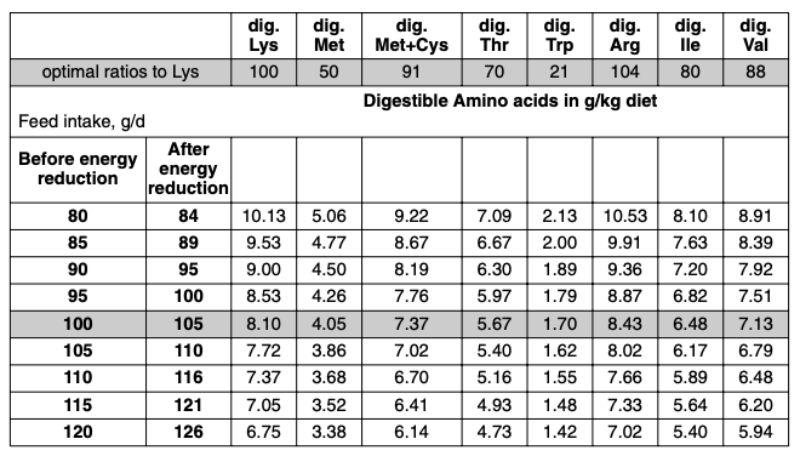
Table 5: Diet formulations for laying hens using revised amino acid specifications and using
DL-Met, DL-Met and L-Lys HCl, DL-Met and L-Lys HCl and L-Thr or DL-Met, L-Lys
HCl, L-Thr and L-Trp (Protein limiting amino acids are marked with grey cells)
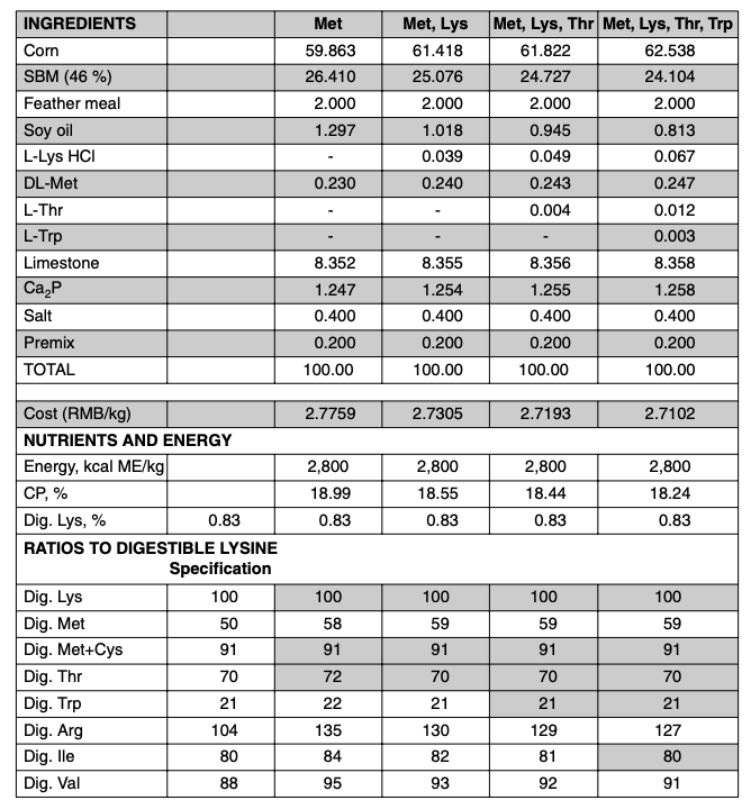
Use of supplemental amino acids helps to balance dietary amino acid profile
The principle of least cost feed formulation is that a number of constraints need to be matched by a suitable combination of ingredients allowing for the most economical solution. Amino acids are provided either in form of proteins which are found in cereals, legumes, by-products from food oil production, animal by products etc. or as free amino acids. Currently, DL-Met, L-Lys sources, L-Thr, and L-Trp are commercially available as amino acids. However, based on the analysis of several hundred samples of layer feed, often only DL-Met is used. However, the inclusion of the other amino acids can help reduce dietary protein as well as feed costs. In Table 5, corn-soybean meal diets with feather meal were formulated using the amino acid specifications obtained from Table 3 and Chinese raw material prices from December 2007. In diet 1 only DLMet was made available to least cost formulation, whereas in diet 2, DL-Met and L-Lys HCl were made available. In diets 3 and 4, L-Thr and L-Trp also were offered.In this exercise, the use of the other amino acids beyond DL-Met decreased the use of SBM and increased the inclusion level of corn. As such, dietary protein level was decreased stepwise as these other amino acids were made available. The use of these other amino acids allowed the diet to better match the specified constraints. This is an important effect from an environmental standpoint, because any reduction in dietary protein level reduces nitrogen excretion. Furthermore, these amino acids (LLys, L-Thr or L-Trp) did not have to be forced into these diets, suggesting that they were needed to minimise feed cost. Consequently, feed costs were gradually reduced from diet 1 to diet 4. These examples clearly demonstrate that the use of supplemental amino acids allow for minimising feed prices, and for better balancing the dietary amino acid profile.
Bonekamp, R.P.R.T., A. Lemme, P.J.A. Wijtten, and J.K.W.M. Sparla (2007): Effects of amino acids on egg number and egg mass of brown (heavy) and whithe (light) hens. 16th European Symposium on Poultry Nutrition, August 26-30, Strasbourg, France: 113-116.
Bregendahl, K., S.A. Roberts, B. Kerr, and D. Hoehler (2008): Ideal ratios of isoleucine, methionine, methionine plus cysteine, threonine, tryptophan and valine relative to lysine for white Leghorn-type laying hens of twenty-eight to thirty-four weeks of age. Poultry Science 87: 744-758.
Coon, C. and B. Zhang (1999): Ideal amino acid profile for layers examined. Feedstuffs 71 (14): 13-15+31.
Elliot, M.A. (2008): Amino acid nutrition of commercial pullets and layers, California Animal Nutrition Conference, May 21- 22, Fresno, California: 139-165.
GfE (Gesellschaft für Ernährungsphysiologie) (1999): Empfehlungen zur Energie- und Nährstoffversorgung der Legehennen und Masthühner. DLG Verlag, Frankfurt a. Main, Germany: 185.
Jais, C., F.X. Roth, and M. Kirchgessner (1995): The determination of the optimum ratio between the essential amino acids in laying hen diets. Archiv für Geflügelkunde 59: 292-302.
Joly, P. (2007): Re-evaluation of amino acids requirements for laying hens Part 1: Methionine and cystine requirements. ISA Hendix Genetics: 13.
Leeson, S. and J.D. Summers (2005): Commercial Poultry Nutrition – 3rd edition. University Books, Ontario, Canada: 398.
Lemme, A. (2007): How to adjust dietary amino acids to energy in broiler diets? AminoNews™ 8 (2): 13-24.
Morris, T.R. (2004): Nutrition of chicks and layers, World’s Poultry Science Journal 60: 5-18.
Rostagno, H.S. (2005): Brazilian Tables for Poultry and Swine – 2nd edition. Federal University Vicosa: 181.
Wijtten, P.J.A., A., Lemme, J. van Wichen, J.K.W.M. Sparla, D.J. Langhout, (2006): Amino acid requirements in laying hens at different energy intakes. 12th European Poultry Conference, August 10-14, Verona, Italy: 5.
META-ANALYSIS
Bateman, A., Z. Liu, and D.A. Roland Sr. (2005): Bioefficiency determination of methionine hydroxy analog-free acid relative to DL-methionine in laying hen diets with limited methionine using different regression models. International Journal of Poultry Science 4: 628-632.
Bertram, H.-L., J.B. Schutte, and J. de Jong (1995a): Influence of DL-methionine supplements on the performance of laying hens under heat stress. Archive für Geflügelkunde 59: 314-318.
Bertram H.-L., E. Dänner, K. Jeroch, and H. Jeroch (1995b): Effect of DL-methionine in a cereal-pea diet on the performance of brown laying hens. Archiv für Geflügelkunde 59: 103-107.
Calderon, W.M., and L.S. Jensen (1990): The requirement for sulphur amino acid by laying hens as influenced by the protein concentration. Poultry Science 69: 934-944.
Dänner, E.E. and Bessei, W. (2002): Effectiveness of liquid DL-methionine hydroxyl analogue-free acid (DL-MHA-FA) compared to DL-methionine on performance of laying hens. Archiv für Geflügelkunde 66: 97-101.
Filho, J.J., J.H. Vilar da Silva, E. Lindolfo da Silva, M.L. Gomes Ribeiro, T.D. Dantas Martins, and C. Boa-Viagem Rabello (2006): Methionine+Cystine requirements of semi-heavy laying hens from the starter to peak of egg production. Rivista Brasileira de Zootecnia 35: 1063-1069 (supl.).
Fuente Martinez, B., A. Diaz Cruz, J. Lecumberri Lopez, and E. Ávila González (2005): Digestible lysine and sulfur amino acids requirements in white leghorn hens. Veterinaria México 36 (2): 135-145.
Lemme, A., H.S. Rostagno, A. Knox and A. Petri, (2004): Responses of laying hens to graded levels of dietary methionine. 22nd World’s Poultry Congress, June 8-13, Istanbul, Turkey: 4.
Mack, S., D. Hoehler and E. Esteve-Garcia (1999): Responses to methionine supplementation of different white egg-type laying hen strains under heat stress. 12th European Symposium on Poultry Nutrition, August 15-19, Veldhoven, Netherlands.
Narváez-Solarte, W., H.S. Rostagno, P.R. Soares, M.A. Silva, and L.F. Uribe Velasquez, (2005): Nutritional requirements in methionine+cystine for white-egg laying hens during the first cycle of production. International Journal of Poultry Science 4: 965-968.
Narváez-Solarte, W. (1996) in: H.S.Rostagno, P. Barbarino Jr., and W.A. Barboza, Nutrient requirements of poultry determined in Brazil, International Symposium on Nutritional Requirements of Poultry and Swine, September 24-26, Vicosa, Brazil: 81-107.
Novak, C., H. Yakout and S. Scheideler (2004): The combined effects of dietary lysine and total sulphur amino acid level on egg production parameters and egg components in Dekalb Delta laying hens. Poultry Science 83: 977-984.
Schutte, J.B., J. de Jong, , and H.L. Bertram (1994): Requirement of the laying hen for sulphur amino acids. Poultry Science 73: 274-280.
Zusammenfassung
Aminosäurenempfehlungen für Legehennen• Neueste wissenschaftliche Forschungen wurden bei der Revision der Aminosäurenempfehlungen für Legehennen in Betracht gezogen. Berücksichtigt man, dass Methionin die erstlimitierende Aminosäure bei Legehennen ist, so hat eine Meta-Analyse gezeigt, dass die optimale Aufnahme an verdaulichem Methionin bei 415 mg pro Henne und Tag liegt.
• In der Literatur wurden optimale verdauliche Verhältnisse von Methionin, Methionin+Cystin, Threonin, Tryptophan, Arginin, Isoleucin und Valin zu verdaulichem Lysin von 50, 91, 70, 21, 104, 80 beziehungsweise 88 % vorgeschlagen.
• Wenn die metabolisierbare Energie im Futter reduziert werden muss, dann sollten die essentiellen Aminosäuren ebenfalls reduziert werden, wenn auch in einem geringeren Ausmaß.
• Eine Optimierung des Aminosäurenprofils der Diät und eine Reduzierung der Futtermittelkosten kann nur über den kompletten Satz kommerziell verfügbarer Aminosäuren erreicht werden.
